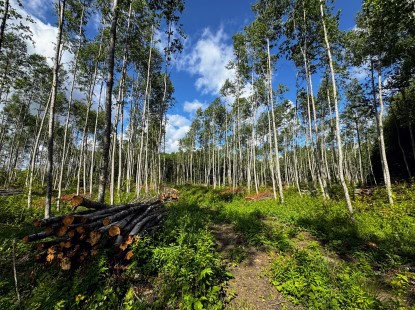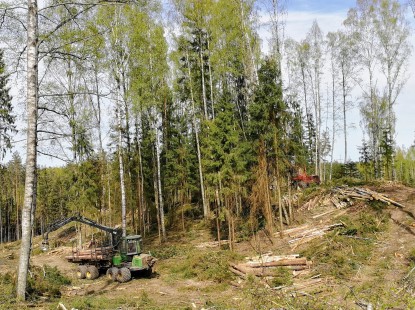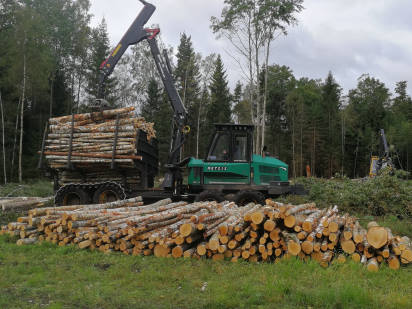Purchase of Cutting Rights
We Purchase Cutting Rights Across Estonia
Selling cutting rights allows a forest owner to earn income from their forest while retaining land ownership. This means that, unlike selling the entire forest property, you maintain control over your forest land and its future potential – be it reforestation, inheritance for future generations, or use for other personal or business purposes.

Timberstock is an experienced forestry company that supports the entire process from start to finish—from initial consultation to forest valuation, logging operations, wood chip production, aftercare, and reforestation.
With our full-service approach, you avoid intermediaries and can be confident that your forest is in reliable hands and that the transaction proceeds smoothly and beneficially for both parties.


How Is the Price of Cutting Rights Determined?
Fixed-Price Cutting Rights Purchase
A fixed-price cutting rights purchase means that the price is set at the time of contract signing and remains unchanged throughout the logging operations. This option is suitable for those who prefer stability and the assurance that the price is fixed and not dependent on timber market fluctuations. On the downside, in a fixed-price sale, it may happen that timber market prices rise during the planning and execution of logging operations, and the owner does not benefit from this increase.
Cutting Rights Purchase Based on Yield
A cutting rights purchase based on yield means that the final payment depends on the quantity and quality of the harvested timber, with the final price and volume determined at the end of logging operations based on the sold timber material. This option allows the forest owner to potentially earn more income if the realized timber volume exceeds forecasts and market prices are favorable at the end of the work. However, one must also consider the potential realization of negative risks (price decline trend, pests).
Both models have their advantages, and suitability depends on the forest owner’s personal preferences and market conditions. At Timberstock, we continuously monitor timber market price trends and can offer accurate recommendations for both short-term and long-term price movements, helping you choose the appropriate pricing model.
Cutting Rights Purchase and Sale Process
- 1) Initial Consultation
- 2) Forest Valuation
- 3) Contract Signing and Payment
- 4) Logging Operations
- 5) Forest Land Aftercare
Every cutting rights purchase and sale process begins with an initial consultation, where we gain an understanding of your goals and the history of the property. It’s wise not to rush and take the time to clarify your expectations and objectives. It may turn out, for example, that instead of selling cutting rights, selling the entire forest property is a more sensible choice.
During the consultation, we discuss how the forest has been managed so far and what your wishes and future plans are, so we can offer solutions that truly meet your needs. If needed, we will explain tax obligations (and potential tax reliefs) related to the sale of cutting rights.
After the consultation, we prepare an initial value assessment for you, based on the forest management plan and forest notification. The preliminary offer considers several factors, including the location of the forest, accessibility, wood quality, and market conditions.
If our initial offer is within an acceptable range for you, our specialist will visit the property to assess the condition of the forest and prepare a final price offer that more accurately reflects the state of the forest and other factors influencing its valuation.
Note: If you need assistance submitting the forest notice to the Environmental Board, we are always ready to help you with that.
If the price offer and agreed terms are acceptable to you, we will proceed to the contract signing. The contract specifies the exact volume and area of the logging operations, as well as agreements on payment terms and the timing of the logging activities. We handle all necessary documentation, which we send to you for review and confirmation, followed by the mutual signing of the contract at the agreed time.
For logging operations, we use our fleet of machinery, which covers the entire territory of Estonia. If the location of the property has specific characteristics, we can involve partners as needed to ensure that the logging work is carried out in the most optimal way.
After logging, we store the timber in the agreed area and arrange its transportation for further processing in sawmills or port terminals, where the wood is further refined. Low-value firewood is utilized for the production of wood chips and pellets. Thanks to long-term partnerships, we can ensure a competitive price for your timber.
After the completion of logging operations, we prepare a report on the work done and monitor the condition of the property to ensure the optimal state of the forest land. According to agreements set, we will perform smoothing of machinery tracks and roads used and establish drainage ditches to prevent the accumulation of excess surface water.
Aftercare helps ensure that your forest regenerates and creates value for the future. If reforestation is agreed upon in the contract, we carry it out according to your wishes and best forestry practices.
Why Choose Us as Your Cutting Rights Purchase/Sale Partner?
Secure and Smooth Transaction
Fair Price for Your Forest
Full Service Without Intermediaries
Sustainable Forest Management
Customer Satisfaction
Contact Us

